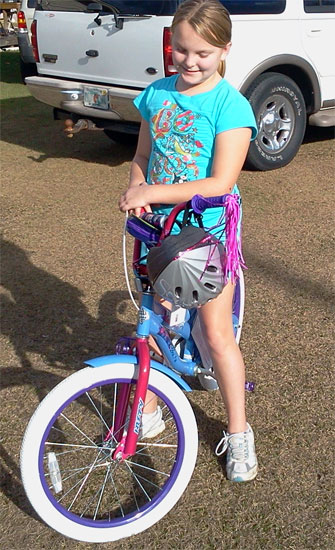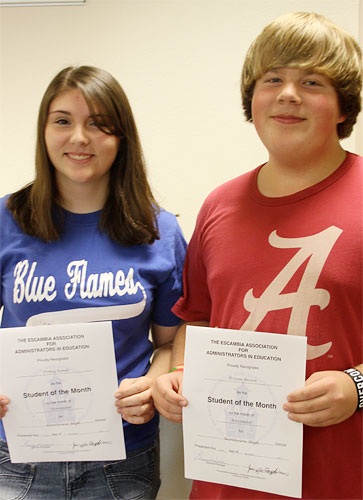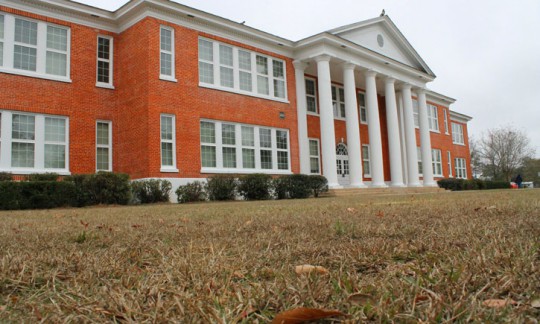Trent Richardson Checks Out All-Star Game, Meets Locals
December 17, 2011
 Alabama Crimson Tide running back and Heisman Trophy finalist Trent Richardson attended the Subway High School All-Star Football Game at Woodham Middle School Friday night. Richardson, pictured top center, took the time to pose for photos with the Northview High School cheerleaders. Submitted photo for NorthEscambia.com, click to enlarge.
Alabama Crimson Tide running back and Heisman Trophy finalist Trent Richardson attended the Subway High School All-Star Football Game at Woodham Middle School Friday night. Richardson, pictured top center, took the time to pose for photos with the Northview High School cheerleaders. Submitted photo for NorthEscambia.com, click to enlarge.
Jim Allen Students Receive Free Bikes, Helmets
December 17, 2011
 Thirty students at Jim Allen Elementary School in Cantonment received new bicycles and helmets from Academy Sports and Outdoors.
Thirty students at Jim Allen Elementary School in Cantonment received new bicycles and helmets from Academy Sports and Outdoors.
Pictured: Jim Allen Elementary School third grader Riley Williamson could not wait to get home Friday afternoon to enjoy her new bicycle compliments of Academy Sports and Outdoors. Submitted photo for NorthEscambia.com, click to enlarge.
Manna Hat Auction Sets New Record
December 16, 2011
The sixth year of the annual Manna Hat Auction from Cat Country 98.7 set a new record Friday morning at $1,676, up from $1,250 last year.
All of the proceeds will be presented to the food bank before Christmas. That, according to the radio station, will allow Manna Food Pantries to feed 57 area residents for five days.
High bidder was Larry Clemons of Pace. He said “the fact that Manna is able to help of some folks who can’t eat” is the reason he continued to drive for the winning bid.
Country artists like CMA Male Vocalist of the Year Blake Shelton and his wife Miranda Lambert helped out by autographing the special hat that was sold on eBay.
ACA Artist of the Decade Toby Keith, a second time signer, said “it is awesome to be able to help.”
“This year the need is particularly great,” Brent Lane said about the need at Manna Food Pantries. “There has been an increase of 24 percent in services.”
Submitted photos for NorthEscambia.com, click to enlarge.
Photo Gallery: Molino Park Presents Jingle Bell Jukebox
December 16, 2011
 The second graders at Molino Park Elementary School present “Jingle Bell Jukebox” twice on Thursday — once in the afternoon for the entire school and again in the evening for parents.
The second graders at Molino Park Elementary School present “Jingle Bell Jukebox” twice on Thursday — once in the afternoon for the entire school and again in the evening for parents.
For a Northescambia.com photo gallery from the musical, click here.
Picture: Molino Park Elementary School second graders perform “Jingle Bell Jukebox” Thursday. NorthEscambia.com photos, click to enlarge.
Photo Gallery: Santa Visits Century Branch Library
December 16, 2011
The Century Branch Library held their annual Christmas event Thursday afternoon. Dozens of children had a chance to presents for everyone and a personal visit with Santa Claus.
From dolls to iPads to computers, Santa heard all kinds of Christmas wishes from the children.
For a NorthEscambia.com photo gallery from the event, click here.
Pictured: Santa paid a special visit to the Century Branch Library Thursday afternoon. NorthEscambia.com photos, click to enlarge.
Northview, Ernest Ward Name Students Of The Month
December 15, 2011
 Students of the month for November were recently named at Ernest Ward Middle and Northview High schools.
Students of the month for November were recently named at Ernest Ward Middle and Northview High schools.
Pictured above: Ernest Ward Students of the Month were (L-R) Ladarrious Thames, Cody Kite and Desmone Knight. Pictured left: Penny Banda and Tristan Brown were Students of the Month from Northview High School. Submitted photos for NorthEscambia.com, click to enlarge.
Sammy Day Named Northview Teacher Of The Year
December 14, 2011
 Northview High School Athletic Director Sammy Day has been named the school’s Teacher of the Year.
Northview High School Athletic Director Sammy Day has been named the school’s Teacher of the Year.
Day, who will retire at the end of this school year, has been a teacher and coach for 37 years in the Escambia County School District and has served as athletic director and coach at Northview High School since the school opened. He also currently teaches driver’s education at Northview.
Teachers of the year are chosen by the faculty and staff at each school in the county. The Escambia County Teacher of the Year will be announced at the annual Golden Apple Awards Dinner in February 2012.
Alabama’s First County High School Recognized
December 14, 2011
The first public county high school in the state of Alabama is being recognized. A new historical marker at the Atmore YMCA Community Center marks the site of the original Escambia County High School building.
Plans for the school began in the last 1800’s with the school completed in 1909. That building later burned.
The current 1926 building was acquired by the Atmore Lions Club in 1989 and later dedicated as the Atmore Lions Community Center in 1991. In 2004, the building was donated to the Atmore Area YMCA.
The marker placed by the Escambia County (Ala.) Historical Society; the second marker to be placed in the county by the group. The first marker placed at Pollard Methodist Church, the oldest church building in Escambia County, Ala.
Pictured: The Atmore YMCA Community Center building, constructed in 1926, was the first public high school building in Alabama. NorthEscambia.com photos, click to enlarge.
Cat’s Hat: Bid On Autographed Country Star Hat For Manna Food Pantries
December 13, 2011
The annual Cat Country 98.7 Manna Hat Auction is underway to raise much needed funds for Manna Food Pantries.
The hat is autographed by a long list of country stars, including award winners like Little Big Town, Kenny Chesney, Jason Aldean, Chris Young, Miranda Lambert, Blake Shelton, Erick Church and Toby Keith.
The autographs were collected at various concerts and events by Cat Country’s Brent Lane.
“This year the need is particularly great,” Brent Lane said about the need at Manna Food Pantries. “There has been an increase of 24 percent in services.”
One hundred percent of the auction proceeds will be donated by Cat Country to the Manna Food Pantries. That hat is listed on ebay in an auction that ends Friday morning.
To view the auction and make a bid, click here.
Weekend In Photos: Parades, Santa Takes A Harley, Animal Seizure
December 12, 2011
If you missed NorthEscambia.com over the weekend, you missed over 300 photos from several community and news events. Click an item below to view the corresponding story and/or photo gallery.
















